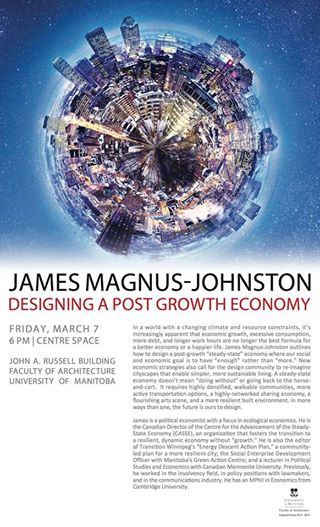John A. Russell Building
Faculty of Architecture
UNiversity of Manitoba
In a world with a changing climate and resource constraints, it’s increasingly apparent that economic growth, excessive consumption, more debt, and longer work hours are no longer the best formula for a better economy or a happier life. James Magnus-Johnston outlines how to design a post-growth “steady-state” economy where our social and economic goal is to have “enough” rather than “more.” New economic strategies also call for the design community to re-imagine cityscapes that enable simpler, more sustainable living. A steady-state economy doesn’t mean “doing without” or going back to the horse-and-cart. It requires highly densified, walkable communities, more active transportation options, a highly-networked sharing economy, a flourishing arts scene, and a more resilient built environment. In more ways than one, the future is ours to design.
James is a political economist with a focus in ecological economics. He is the Canadian Director of the Centre for the Advancement of the Steady-State Economy (CASSE), an organization that fosters the transition to a resilient, dynamic economy without “growth.” He is also the editor of Transition Winnipeg’s “Energy Descent Action Plan,” a community-led plan for a more resilient city; the Social Enterprise Development Officer with Manitoba’s Green Action Centre; and a lecturer in Political Studies and Economics with Canadian Mennonite University. Previously, he worked in the insolvency field, in policy positions with lawmakers, and in the communications industry. He has an MPhil in Economics from Cambridge University.
